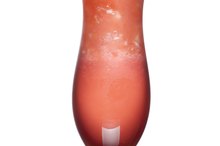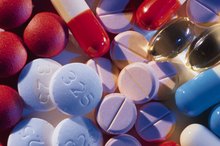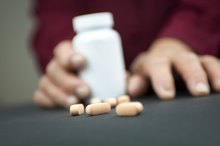Vitamins Depleted by Alcohol
Used in moderation, alcohol appears to confer some health benefits. The American Heart Association reports that moderate intake of alcohol, 1 or 2 drinks daily, increases HDL cholesterol and reduces your risk of coronary heart disease. However, the adverse effects of excessive use of alcohol are well-documented. Among the risks of alcohol abuse are various nutritional deficiencies, including vitamins, minerals, essential fatty acids and proteins.
If you are experiencing serious medical symptoms, seek emergency treatment immediately.
Thiamin, Niacin and Pyridoxine
Although alcohol itself is devoid of useful nutrition, it is preferentially processed in your liver by vitamin-dependent enzymes that are also responsible for the metabolism of other compounds, such as carbohydrates and proteins. According to nutritionist Elson Haas, vitamins B-1, B-3 and B-6, or thiamin, niacin and pyridoxine, are directly or indirectly involved in alcohol metabolism, and they are among the first nutrients to be depleted by excessive alcohol consumption.
Riboflavin and B12
Thiamine & Alcoholism
Learn More
Your liver needs glutathione and other antioxidants to detoxify alcohol, and these compounds are not efficiently regenerated in persons who drink too much or too often. A 2011 study published in “Alcoholism, Clinical and Experimental Research” demonstrated that alcohol causes glutathione depletion, which lessens your liver's ability to metabolize alcohol 3. Since glutathione may also be required for optimal vitamin B-12 function, heavy alcohol use creates a relative B-12 deficiency. Furthermore, an alcohol-damaged liver is less capable of storing vitamin B-12. Finally, vitamin B-2, or riboflavin, is needed to regenerate glutathione, so this vitamin, too, is depleted by alcohol.
- Your liver needs glutathione and other antioxidants to detoxify alcohol, and these compounds are not efficiently regenerated in persons who drink too much or too often.
- Finally, vitamin B-2, or riboflavin, is needed to regenerate glutathione, so this vitamin, too, is depleted by alcohol.
Ascorbic Acid and Fat Soluble Vitamins
The nutritional problems associated with alcohol abuse are directly related to the amount of alcohol consumed. Chronic alcohol abuse suppresses your appetite, which leads to poor intake of nutrient-rich foods. A lack of wholesome foods in your diet reduces the availability of the fat-soluble vitamins, A, D, E and K, and nearly all of the B complex vitamins, including thiamin, niacin, folate, vitamin B-6, biotin and vitamin B-12. Ascorbic acid, or vitamin C, is also commonly depleted.
- The nutritional problems associated with alcohol abuse are directly related to the amount of alcohol consumed.
- Chronic alcohol abuse suppresses your appetite, which leads to poor intake of nutrient-rich foods.
Recommendations
The Effects of Malnutrition & Alcoholism
Learn More
Excessive use of alcohol is associated with serious adverse health consequences, including vitamin deficiencies that involve depletion of B complex vitamins, ascorbic acid and the fat-soluble vitamins. Vitamin replacement therapy, particularly with thiamin, which is directly involved in alcohol and carbohydrate metabolism, is essential for persons who chronically overuse alcohol. Although vitamin supplements are not a substitute for a well-balanced diet, daily supplementation with B vitamins, ascorbic acid and fat-soluble vitamins is worthwhile for people who consume several alcoholic beverages daily. Commercially available vitamin supplements are sufficient for most individuals.
- Excessive use of alcohol is associated with serious adverse health consequences, including vitamin deficiencies that involve depletion of B complex vitamins, ascorbic acid and the fat-soluble vitamins.
Related Articles
References
- “Circulation”; Wine and Your Heart: A Science Advisory for Healthcare ProfessionalsFrom the Nutrition Committee, Council on Epidemiology and Prevention, and Council on Cardiovascular Nursing of the American Heart Association; I.J. Goldberg, et al.; January 2001
- “Staying Healthy with Nutrition”; Elson M. Haas, M.D.; 2006
- Alcoholism, Clinical and Experimental Research”; Ethanol Lowers Glutathione in Rat Liver and Brain and Inhibits Methionine Synthase in a Cobalamin-Dependent Manner; M.I. Waly, et al.; February 2011
- National Institute on Alcohol Abuse and Alcoholism. Alcohol Metabolism: An Update. Alcohol Research & Health. 2007;30(1).
- Taylor B, Rehm J. The relationship between alcohol consumption and fatal motor vehicle injury: high risk at low alcohol levels. Alcohol Clin Exp Res. 2012;36(10):1827-34. doi:10.1111/j.1530-0277.2012.01785.x
- Ferré S, O'Brien MC. Alcohol and caffeine: The perfect storm. J Caffeine Res. 2011;1(3):153-162. doi:10.1089/jcr.2011.0017
- Stornetta A, Guidolin V, Balbo S. Alcohol-derived acetaldehyde exposure in the oral cavity. Cancers (Basel). 2018;10(1):20. doi:10.3390/cancers10010020
- Hadland SE, Levy S. Objective testing: Urine and other drug tests. Child Adolesc Psychiatr Clin N Am. 2016;25(3):549-65. doi:10.1016/j.chc.2016.02.005
- Stewart SH, Koch DG, Willner IR, Randall PK, Reuben A. Hair ethyl glucuronide is highly sensitive and specific for detecting moderate-to-heavy drinking in patients with liver disease. Alcohol Alcohol. 2013;48(1):83-7. doi:10.1093/alcalc/ags109
- Fillmore MT, Jude R. Defining "binge" drinking as five drinks per occasion or drinking to a .08% BAC: which is more sensitive to risk? Am J Addict. 2011;20(5):468-75. doi:10.1111/j.1521-0391.2011.00156.x
- American Association for Clinical Chemistry. Ethanol. 2018.
- Cederbaum A. Alcohol metabolism. Clinics in Liver Disease. 2012;16(4):667-685. doi:10.1016/j.cld.2012.08.002
- LabCorp, Inc. Drugs of Abuse Reference Guide. 2007.
- National Institute on Alcohol Abuse and Alcoholism. Alcohol Metabolism: An Update. Alcohol Research & Health. 2007;30(1).
Writer Bio
Stephen Christensen started writing health-related articles in 1976 and his work has appeared in diverse publications including professional journals, “Birds and Blooms” magazine, poetry anthologies and children's books. He received his medical degree from the University of Utah School of Medicine and completed a three-year residency in family medicine at McKay-Dee Hospital Center in Ogden, Utah.









